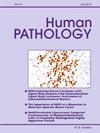GNAQ-/GNA14-mutated hepatic vascular malformation with capillary proliferation in adults and children
IF 2.6
2区 医学
Q2 PATHOLOGY
引用次数: 0
Abstract
Aims
Congenital hepatic vascular malformation with capillary proliferation (HVMCP) is a rare pseudo-tumourous liver lesion, to date only known in children. Diagnostic pitfalls in infant and, for the first time, in adult cases are histomorphologically characterised and molecularly analysed on driver mutations playing a role in angiogenesis and angioproliferation.
Methods and results
We histomorphologically characterised 4 early childhood and 2 adult cases, which showed malformed venous, cavernous and dissecting CD34-positive, GLUT1-negative capillary formations, followed by trabecular disarrangement of the involved liver parenchyma. As shown exemplarily, infant cases can lead to misdiagnosis as Glypican 3-positive hepatoblastoma. In adults, broadened capillarized liver trabecules might imitate hepatocellular carcinoma and dense capillary formations can resemble endothelial tumours, particularly hepatic small vessel neoplasia. In all cases, vascular malformation was the diagnostic key feature. Custom hybrid-capture-based sequencing assays were conducted, covering a broad range of genes active in angiogenesis and angioproliferation. Of the cases, 3, including 1 adult case, showed pathogenic activating driver mutations in GNAQ/GNA14. One adult lesion proved to be wild-type. Two wedge biopsies did not allow for molecular analysis.
Conclusions
HVMCP has to be differentiated from true vascular neoplasms, particularly from hepatic congenital haemangioma, hepatic infantile haemangioma and hepatic small vessel neoplasia but also from solid malignant hepatocellular tumours. Recognition of the underlying vascular malformation might disclose the pseudotumourous nature even in biopsies. Detection of driver mutations in the Gqα-protein-coding gene family with activation of the downstream MAPK/ERK pathway may open up a future treatment option for non-resectable lesions with MAPK/ERK inhibitors.
Clinical trial number
Ethic Votum BioMaSota No.13-091.
成人和儿童GNAQ-/ gna14突变肝血管畸形伴毛细血管增生
目的:先天性肝血管畸形伴毛细血管增生(HVMCP)是一种罕见的假肿瘤性肝脏病变,迄今为止仅在儿童中发现。在婴儿和成人病例的诊断缺陷中,首次对在血管生成和血管增殖中起作用的驱动突变进行了组织学表征和分子分析。方法和结果:我们对4例早期儿童和2例成人的组织学特征进行了分析,表现为静脉、海绵状和夹层毛细血管形成畸形,cd34阳性,glut1阴性,并伴有累及的肝实质小梁紊乱。如例所示,婴儿病例可被误诊为Glypican 3阳性肝母细胞瘤。在成人中,增宽的毛细血管化肝小梁可能类似于肝细胞癌,致密的毛细血管形成可能类似于内皮肿瘤,尤其是肝小血管瘤。在所有病例中,血管畸形是诊断的关键特征。进行了定制的基于杂交捕获的测序分析,涵盖了血管生成和血管增殖中广泛的活性基因。其中3例(包括1例成人)GNAQ/GNA14出现致病性激活驱动突变。一个成人病变被证明是野生型。两次楔形活检不能进行分子分析。结论:HVMCP必须与真正的血管肿瘤鉴别,特别是与肝先天性血管瘤、肝婴儿血管瘤和肝小血管瘤鉴别,但也必须与实性恶性肝细胞瘤鉴别。即使在活组织检查中,对潜在血管畸形的识别也可能揭示假肿瘤的性质。检测gq α-蛋白编码基因家族的驱动突变,激活下游MAPK/ERK通路,可能为未来使用MAPK/ERK抑制剂治疗不可切除病变开辟一种选择。临床试验号:ethical Votum BioMaSota 13-091。
本文章由计算机程序翻译,如有差异,请以英文原文为准。
求助全文
约1分钟内获得全文
求助全文
来源期刊

Human pathology
医学-病理学
CiteScore
5.30
自引率
6.10%
发文量
206
审稿时长
21 days
期刊介绍:
Human Pathology is designed to bring information of clinicopathologic significance to human disease to the laboratory and clinical physician. It presents information drawn from morphologic and clinical laboratory studies with direct relevance to the understanding of human diseases. Papers published concern morphologic and clinicopathologic observations, reviews of diseases, analyses of problems in pathology, significant collections of case material and advances in concepts or techniques of value in the analysis and diagnosis of disease. Theoretical and experimental pathology and molecular biology pertinent to human disease are included. This critical journal is well illustrated with exceptional reproductions of photomicrographs and microscopic anatomy.
 求助内容:
求助内容: 应助结果提醒方式:
应助结果提醒方式:


